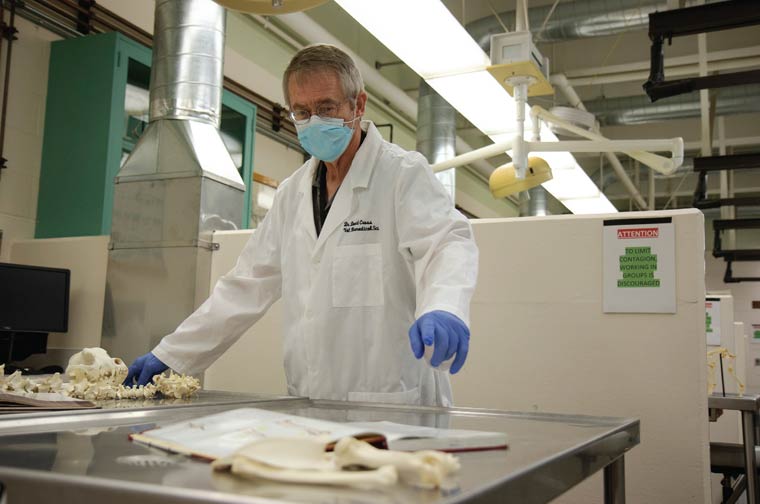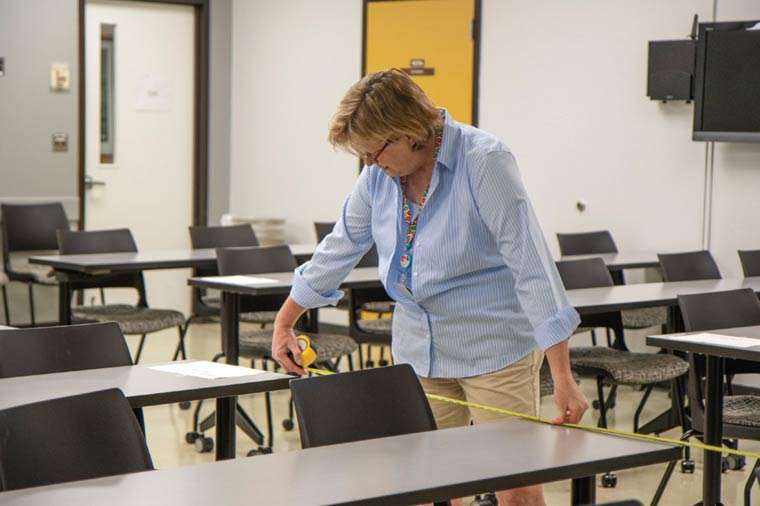
August 01, 2020
New school year brings hybrid curriculum
How do you fit 100 students in a lecture hall when they must stay 6 feet apart? That’s a question many veterinary educators are working to answer.

Dr. Laura Nelson, associate dean and director of academic affairs at North Carolina State University College of Veterinary Medicine, said classrooms at the veterinary college aren’t big enough for the average student class of 100 students because of COVID-19–related social distancing.
“When those realities sank in, we realized we needed to adapt,” Dr. Nelson said. “We can’t fill our rooms like we are used to.”
JAVMA News spoke with several veterinary college deans about how they plan to educate students this fall in the face of safety, health, and budgetary concerns related to COVID-19. Some veterinary colleges report moving the semester start date up and adopting a hybrid curriculum that will break students into smaller groups, with half on campus and the other half online at any given time.
NC State’s veterinary college will, beginning in August, break its preclinical students into 25-person subgroups for on-campus laboratory sessions, and there will only be 150 students on campus at any one time. Some lectures will be offered via distance learning.

In the clinic
The University of Tennessee College of Veterinary Medicine, the University of Missouri College of Veterinary Medicine, and Kansas State University College of Veterinary Medicine were the first three institutions to bring fourth-year students back to campus for clinical rotations in June.
Dr. Carolyn J. Henry, dean of Mizzou’s veterinary college, said some fourth-year students returned in June, and others returned in July, depending on the rotation they were on.
Most veterinary colleges are breaking up their fourth-year student cohort into smaller groups, while also providing more distance learning options.
Dr. Henry said half of the 120 fourth-year students will work remotely, and half will do hands-on work in the clinic. She said some of the changes allow for a better learning experience.
“If you have gone to veterinary school, you know when you go through clinical rotations, if there are a lot of students, you may not get to do much. But in this way, the day you are on, you are hands on. You don’t have to wait around,” Dr. Henry said. “In that regard, as a student, I would have preferred it.”
Dr. Henry said she expects some practices, such as offering more online content and distance learning opportunities, to continue even after a COVID-19 vaccine is released or public health guidelines are relaxed.
“I don’t want to glorify COVID-19, but there is a lot of good coming from it,” she said. “We are moving forward in a different way, but we are going to make it better.”
Health concerns
Dr. James Thompson, dean of the UT veterinary college, said the veterinary teaching hospital reopened to students on June 1, and the staff faced a potential COVID-19 case nearly a week later.
“It makes us nervous because we are bringing people in from multiple places, and we are trying to control a pandemic we are not immune to,” said Dr. Thompson. “I am looking forward to a vaccine so we can have our people working shoulder to shoulder.”
A person became sick in early June. Leadership performed contract tracing and found 16 people who had potentially been exposed. Those individuals self-quarantined for 14 days.
Dr. Thompson said it is not if the virus will infect people but when.
“Veterinarians are problem-solvers and this is a problem that needs to be solved,” Dr. Thompson said. “I wish we had a vaccine, but I am confident we can get through this. It is just going to be hard and take time and continued attention.”
The potential health risks from COVID-19 also include mental health concerns. During the pandemic, faculty members are handling a larger workload, and students face an increase in anxiety and stress.
Dr. Nelson at NC State said faculty members are being creative and adapting well, but some are working in clinics, planning a course for the fall, and holding clinical rotations online.
“It is tiring,” she said. “It takes a lot of work, and a lot of work is falling on people ... in the middle of a pandemic.”
Dr. Henry said some students are more apprehensive about returning.
“We fear what is unknown to us,” she said. “The better we can communicate our steps to make people safe, the more those answers will give them calm.”
She said she knows how some students are feeling, especially those who are around vulnerable people. Dr. Henry’s mother is 91 years old.
“I am requiring that everyone wear masks,” she said. “It is being a good citizen at the campus level and looking out for the community you work with.”
Masks will likely be broadly used on campus. There will also be frequent cleaning of surfaces, better air filtration, and more frequent cycling of air through facilities.

Money, money … money?
Fiscal concerns have also come to the forefront as states look to manage the economic fallout of the ongoing coronavirus pandemic.
In May, several state officials began announcing budget cuts that could affect higher education.
Colorado cut $493 million from the higher education budget in May, but Gov. Jared Polis signed an executive order to give $450 million in federal money to the state’s public colleges and universities.
The Iowa legislature made an $8 million cut in higher education funding in June that was followed by student leaders within the state releasing a statement expressing concerns about whom these cuts would affect most.
“The cuts for fiscal year 2021 will be particularly harmful against the backdrop of 30 years of generational disinvestment. And at a time when courageous activists have exposed deep racial inequities in our society,” the statement said, “it must be noted that these cuts will fall hardest on students of color.”
Moody’s Analytics, a financial intelligence and analytics company, released an assessment finding only five states have the reserves to fully absorb the economic stress of the COVID-19 pandemic.
The state of California may cut $2 billion in higher education.
The University of North Carolina System, which oversees higher education in the state, announced in April it is asking for less money in its biennial budget request to the state legislature.
“Finances are always a worry,” said Dr. Nelson at NC State. “We are not anticipating more funding than we are used to. This is not going to be a year of milk and honey.”
Dr. Nelson added that no staff members have been fired or furloughed. However, the veterinary college does have a hiring freeze in place and is being conservative with its finances.
Dr. Henry said the situation at Missouri is similar but also won’t impact students.
“As a university, all the colleges are taking a 12.5% budget cut,” she said. “We are putting off hires, cutting travel, and reducing expenses.”

Zoom talks
For the past few months, veterinary college leaders have been communicating about what the best path forward may be for their institutions. Member organizations of the Association of American Veterinary Medical Colleges, representing 53 veterinary colleges in the U.S. and abroad, have spoken weekly about shared challenges and the future of veterinary education.
Dr. Andrew T. Maccabe, CEO of the AAVMC, said the association facilitated a regular teleconference call and an online sharing platform when the deans first expressed concerns in March.
“They’re all facing different things and looking to one another on how they’re handling the issues,” Dr. Maccabe said. “We are glad to be able to support the connections among the deans during this global crisis.”
Dr. Carlos Risco, dean of Oklahoma State University College of Veterinary Medicine, said the weekly meetings have been helpful to him and other leaders.
“They have served as a compass on how to navigate during the pandemic,” he said.
Long-term changes
Despite the difficult nature of changing a curriculum that has historically been given in person, Dr. Nelson said she hopes some changes will be more permanent.
For example, Dr. Nelson said, students enjoy the online discussion boards and chat sections because they can ask questions during a lecture without interrupting the professor. Many students also enjoy being able to watch a recorded lecture at any time.
“A lot of what we do is because we have always done it that way.” Dr. Nelson said. “We had to reevaluate what is necessary and what is the essence of this thing and how do we move it to a different format? We will never go back to something that was exactly like it was before.”